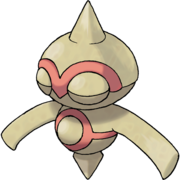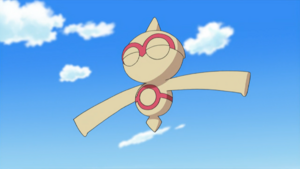From Bulbapedia, the community-driven Pokémon encyclopedia.
|
|
|
|
|
|
|
|
|
|
|
|
|
|
Height
1'08"
Imperial
|
0.5 m
Metric
|
1'08"/0.5 m
Red-Striped
|
0'0"/0.0 m
Blue-Striped
|
0'0"/0.0 m
|
|
|
Weight
47.4 lbs.
Imperial
|
21.5 kg
Metric
|
47.4 lbs./21.5 kg
Red-Striped
|
0.0 lbs./0.0 kg
Blue-Striped
|
0.0 lbs./0.0 kg
|
|
|
|
|
|
|
|
|
|
|
|
|
EV yield
HP
0
|
Atk
0
|
Def
0
|
Sp.Atk
0
|
Sp.Def
1
|
Speed
0
|
| Base Exp.: 58
|
Battle Exp.: 581*
|
|
|
|
|
Baltoy (Japanese: ヤジロン Yajilon) is a dual-type Ground/Psychic Pokémon.
It evolves into Claydol starting at level 36.
Biology
Physiology
Baltoy are small, tan-and-red figurine-like Pokémon that are made out of clay or mud. It balances on a single foot. To maintain this balance, it has two arm-like appendages that even out its center of gravity, therefore making it more stable. Baltoy has a single spike-like protrusion on the top of its head, and its red body markings make its abdomen somewhat resemble a Poké Ball. Baltoy's eyes appear to have arching red eyebrows, and seem perpetually closed or encased in goggles.
Gender differences
Baltoy are a genderless species.
Special abilities
Baltoy possesses psychic powers, and is one of the small amount of Pokémon that can use Cosmic Power. Being a Psychic-type, it can also use moves such as Reflect, Light Screen, and Safeguard.
Behavior
Baltoy moves while spinning around on its one foot. As soon as it spots others of its kind, Baltoy congregates with them and then begins crying noisily in unison. This Pokémon sleeps while cleverly balancing itself on its one foot.
Habitat
Baltoy can be found in deserts.
Diet
- Main article: Pokémon food
In the anime
Major appearances
Baltoy first appeared in Me, Myself and Time, under the ownership of a girl named Calista.
In It's Still Rocket Roll to Me!, Tate and Liza were using Baltoy's Confusion to recreate weightlessness during a Pokémon Battle, even though their main Pokémon already possess the ability to float in mid-air. Later in that same episode, these Clay Doll Pokémon stopped Team Rocket from stealing the rocket ship.
Minor appearances
A Baltoy is owned by one of the students of Snowpoint Trainers' School in Classroom Training!
Another Baltoy appeared in Bucking the Treasure Trend!, under the ownership of Buck.
Pokédex entries
| Episode
|
Pokémon
|
Source
|
Entry
|
| DP181
|
Baltoy
|
Dawn's Pokédex
|
Baltoy, the Clay Doll Pokémon. A rarely seen Pokémon, Baltoy is said to have been discovered in an ancient ruin.
|
|
In the manga
In the Arceus and the Jewel of Life manga
In the manga adaption of Arceus and the Jewel of Life, Marcus owns a Baltoy.
In the TCG
- Main article: Baltoy (TCG)
Game data
Pokédex entries
| This Pokémon was unavailable prior to Generation III.
|
|
|
|
|
| Generation III
|
|
| Ruby
|
Baltoy moves while spinning around on its one foot. Primitive wall paintings depicting this Pokémon living among people were discovered in some ancient ruins.
|
| Sapphire
|
As soon as it spots others of its kind, Baltoy congregates with them and then begins crying noisily in unison. This Pokémon sleeps while cleverly balancing itself on its one foot.
|
| Emerald
|
A Baltoy moves by spinning on its single foot. It has been depicted in murals adorning the walls of a once-bustling city in an ancient age.
|
| FireRed
|
It was discovered in ancient ruins. While moving, it constantly spins. It stands on one foot even when asleep.
|
| LeafGreen
|
{{{leafgreendex}}}
|
|
|
| Generation IV
|
|
| Diamond
|
It moves by spinning on its foot. It is a rare Pokémon that was discovered in ancient ruins.
|
| Pearl
|
{{{pearldex}}}
|
| Platinum
|
{{{platinumdex}}}
|
| HeartGold
|
It moves while spinning around on its single foot. Some Baltoy have been seen spinning on their heads.
|
| SoulSilver
|
{{{soulsilverdex}}}
|
|
|
| Generation V
|
|
| Black
|
It moves by spinning on its foot. It is a rare Pokémon that was discovered in ancient ruins.
|
| White
|
{{{whitedex}}}
|
| Black 2
|
Discovered in ancient ruins, it moves by spinning around and forms a group when it finds others.
|
| White 2
|
{{{white2dex}}}
|
|
|
|
|
Game locations
| This Pokémon was unavailable prior to Generation III.
|
|
|
|
|
|
|
|
|
|
|
|
|
In side games
Stats
Base stats
| Stat
|
Range
|
| At Lv. 50
|
At Lv. 100
|
40
|
|
100 - 147
|
190 - 284
|
40
|
|
40 - 101
|
76 - 196
|
55
|
|
54 - 117
|
103 - 229
|
40
|
|
40 - 101
|
76 - 196
|
70
|
|
67 - 134
|
130 - 262
|
55
|
|
54 - 117
|
103 - 229
|
Total: 300
|
Other Pokémon with this total
|
- Minimum stats are calculated with 0 EVs, IVs of 0, and (if applicable) a hindering nature.
- Maximum stats are calculated with 252 EVs, IVs of 31, and (if applicable) a helpful nature.
|
Pokéathlon stats
Type effectiveness
| Under normal battle conditions in Generation V, this Pokémon is:
|
|
|
|
|
|
|
|
|
|
|
|
|
Learnset
|
|
|
|
- Bold indicates a move that gets STAB when used by Baltoy
- Italic indicates a move that gets STAB only when used by an Evolution of Baltoy
- Click on the generation numbers at the top to see level-up moves from other generations
|
|
|
| Father |
Move |
Type |
Cat. |
Pwr. |
Acc. |
PP
|
| This Pokémon learns no moves by breeding.
|
- Moves marked with an asterisk (*) must be chain bred onto Baltoy in Generation V
- Moves marked with a double dagger (‡) can only be bred from a Pokémon who learned the move in an earlier generation.
- Moves marked with a superscript game abbreviation can only be bred onto Baltoy in that game.
- Bold indicates a move that gets STAB when used by Baltoy
- Italic indicates a move that gets STAB only when used by an Evolution of Baltoy
- Click on the generation numbers at the top to see Egg moves from other generations
|
Side game data
Evolution
Sprites
Trivia
Origin
Its design is similar to the 遮光器土偶 shakōkidogū - a "spaceman" clay figurine from the Jōmon period of Japanese history. It also seems to resemble a top,Hopi Kachina doll, or possibly a dreidel.
Name origin
Baltoy may be a combination of balance and toy.
Yajilon is an abbreviation of 弥次郎兵衛 yajirobe'e (balancing toy).
In other languages
External links

|
This Pokémon article is part of Project Pokédex, a Bulbapedia project that aims to write comprehensive articles on each Pokémon species, as well as Pokémon groups and forms.
|






























